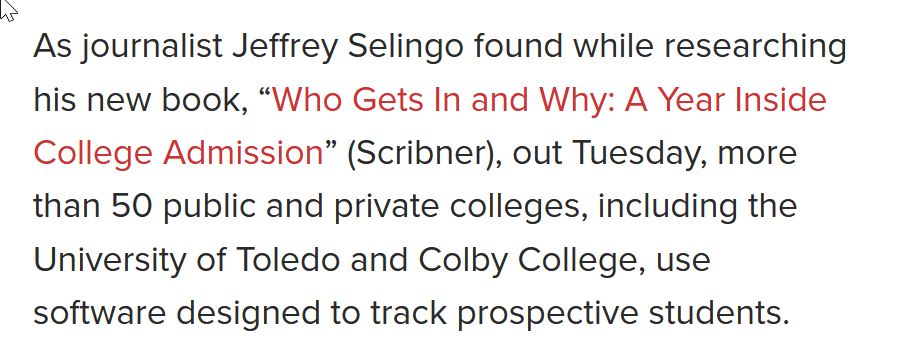
Thread: The year ahead
We're one of those curious points in history when being way up in applications could be a bad thing, and being way down could be a good thing.
Get ready for another year of "we really can't tell" in Enrollment Management and admissions:
We're one of those curious points in history when being way up in applications could be a bad thing, and being way down could be a good thing.
Get ready for another year of "we really can't tell" in Enrollment Management and admissions:
Let's say you're a solid, mid-market college in a large city. Increasing apps could be a hedge for students who think they may have to stay closer to home.
If, by next March, we've contained COVID-19 or developed a vaccine, you become last choice.
If, by next March, we've contained COVID-19 or developed a vaccine, you become last choice.
Let's say you're a flagship or land grant, and you see apps up at this point. This could be those students normally headed out-of-state or to private colleges. You're a hedge against high tuition.
On the other hand, suppose you've wedded yourself to Fast Apps, Snap Apps, VIP apps, and the "click here and you're admitted" apps. You know many of those students are grist for the rejection mill of selectivity, and you know those apps are very soft.
If your apps in core markets and from your feeder schools are solid, you might not miss those vapor apps, except when you have to explain a rising admission rate.
If you work at a place where you have to explain that, I feel sorry for you.
If you work at a place where you have to explain that, I feel sorry for you.
If so, you need to explain those trade-offs now. In fact, if you're doing your job, explaining trade-offs should be a big part of your job at all times.
When my kids were being greedy, I'd ask them, "What does Mick say?" and they knew what to say in their defeated voice:
When my kids were being greedy, I'd ask them, "What does Mick say?" and they knew what to say in their defeated voice:
Of course, I couldn't predict where my own kids were going to go to college on April 27th of their senior years, so maybe they got back at me.
But there are other ways to think about this year too:
But there are other ways to think about this year too:
If you're at a 65% discount rate and continuing to raise tuition, maybe think about whether that makes sense ever, but especially now. (I'm running the 2018 numbers now as time allows, but I remember the last time I looked at 2016 data, there were several creeping up on 80%.)
The thing is, all the rules are out the door right now. Remember when we thought we'd found a negative beta industry (community college enrollments). Well, the economy went in the tank, and CC enrollments went down. WAY down. npr.org/sections/coron…
Of course, the data available to the media are not nuanced, and official enrollment data for LAST fall is still not available on IPEDS. It may be that the CC drop is skewed toward vocational training, for instance. Or it could be per-transfer. Or across the board. Not sure.
Because what was different this year was that the economy wasn't the only thing that changed. Everything changed.
And we don't have any way to predict, or even to make wild guesses when everything changes. You just have to sort of fly blind.
But here's an analogy I often use:
And we don't have any way to predict, or even to make wild guesses when everything changes. You just have to sort of fly blind.
But here's an analogy I often use:
Bringing in enrollment is like landing a jet on an aircraft carrier. In rough waters. At night. With cross winds. Here's a cool video to see what that's like (except of course, for them it's a real life-or-death situation) .
At 5:58 one of the pilot says, "The deck was everywhere." That is an apt metaphor.
But consider that perhaps you had to set all the controls six months before you tried to land. That's our business.
Right now we don't know what our instruments are telling us.
But consider that perhaps you had to set all the controls six months before you tried to land. That's our business.
Right now we don't know what our instruments are telling us.
And we won't until the plane has (we hope) landed and is safe on deck. Here's the last application of the metaphor:
If you have to land the plane, you want an experience pilot with good instruments. But if you can only choose one, you want experience.
Our instruments are out
If you have to land the plane, you want an experience pilot with good instruments. But if you can only choose one, you want experience.
Our instruments are out
Land the plane.
Oh, and #EMTalk
Please, Twitter: Typo edit buttons
• • •
Missing some Tweet in this thread? You can try to
force a refresh











